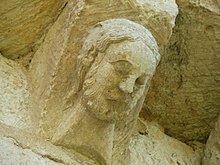Oquillas
| Oquillas parish | ||
|---|---|---|
 Oquillas - Iglesia de San Cipriano
|
||
| coat of arms | Map of Spain | |

|
|
|
| Basic data | ||
| Autonomous Community : |
|
|
| Province : | Burgos | |
| Comarca : | Ribera del Duero | |
| Coordinates | 41 ° 50 ′ N , 3 ° 42 ′ W | |
| Height : | 915 msnm | |
| Area : | 14.98 km² | |
| Residents : | 53 (Jan. 1, 2019) | |
| Population density : | 3.54 inhabitants / km² | |
| Postal code : | 09350 | |
| Municipality number ( INE ): | 09239 | |
| administration | ||
| Website : | Oquillas | |
Oquillas is a northern Spanish town and a municipality ( municipio ) belonging to the poorly populated region of the Serranía Celtibérica with only 53 inhabitants (as of January 1, 2019) in the south of the province of Burgos in the autonomous community of Castile-León .
Location and climate
The place Oquillas is located on the Río Oquillas, a tributary of the Río Esgueva at an altitude of about 915 m . The city of Burgos is just under 65 km (driving distance) to the north; the nearest town is Aranda de Duero (approx. 20 km south). The climate in winter is often harsh, but in summer it is mostly temperate and warm; Rain (approx. 490 mm / year) falls mainly in the winter half-year.
Population development
| year | 1857 | 1900 | 1950 | 2000 | 2018 |
| Residents | 262 | 271 | 225 | 77 | 55 |
The mechanization of agriculture and the abandonment of small farms led to a lack of jobs and a significant decline in the number of inhabitants ( rural exodus ) since the 1950s .
economy
In the past, Oquillas was a self-sufficient farming village in the fertile Esgueva Valley. The field work is done by only a few farmers today; some houses are rented out as holiday apartments (casas rurales) in summer .
history
No evidence has yet been found from the Celtic , Roman , Visigothic and Islamic periods. In the 8th and early 9th centuries, the area was under Islamic influence, but the area was neither permanently settled nor defended by the Berbers due to the unusually harsh and rainy climate . At the end of the 9th century, the Castilian Count Diego Rodríguez Porcelos received from King Alfons III. of Asturias the order to repopulate ( repoblación ) the depopulated land.
Attractions
The most important attraction of the place is the Iglesia de San Cipriano , located approx. 300 m outside . The Romanesque church structure is still largely preserved, but the south porch (portico) and the bell tower (campanario) were added later. The semicircular apse , built from precisely hewn limestone , is structured by means of half-column templates and shows a window accompanied by set columns with capitals . Below the eaves there is a partially figurative console frieze . The nave (nave) received a baroque revision.
Web links
- Oquillas - short information (wikiburgos, Spanish)
- Oquillas - Photos + Info (Flickr, Spanish)
- Romanesque churches in the Esgueva Valley - photos + information (arteguias, Spanish)
Individual evidence
- ↑ Cifras oficiales de población resultantes de la revisión del Padrón municipal a 1 de enero . Population statistics from the Instituto Nacional de Estadística (population update).
- ↑ Oquillas - climate tables
- ↑ Oquillas - population development

